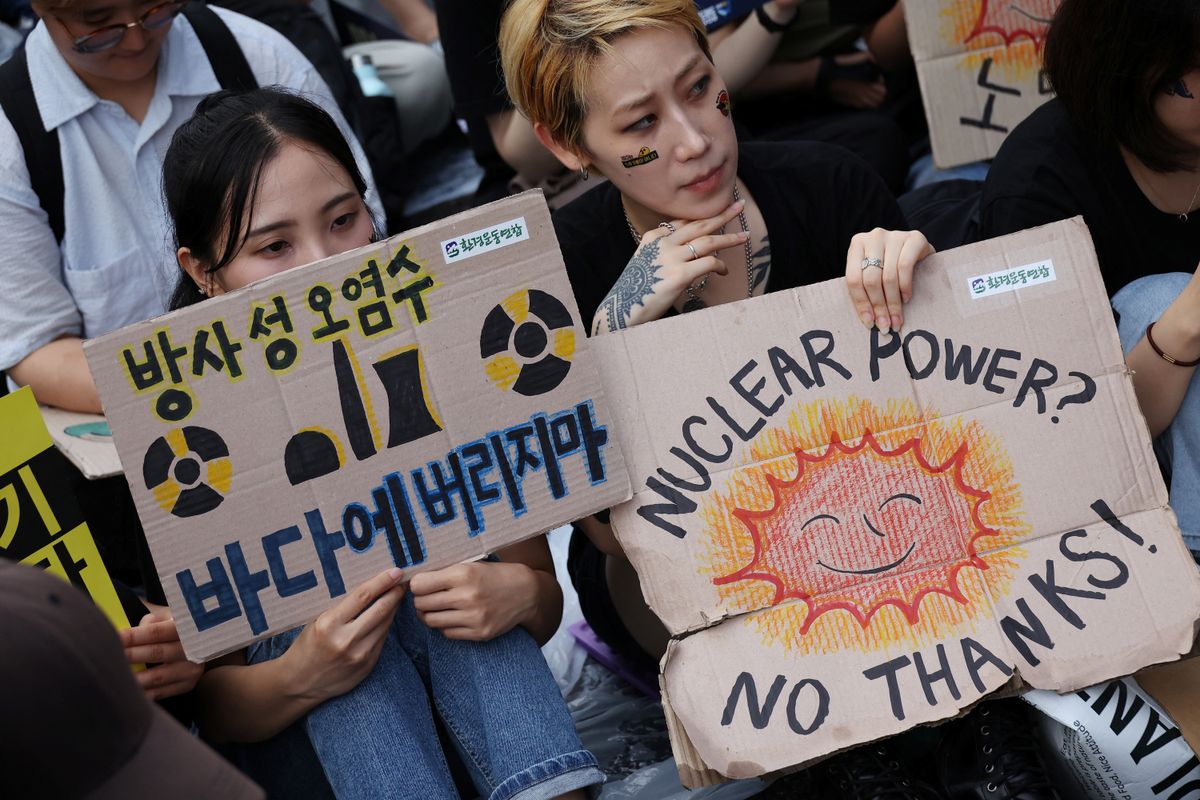South Koreans question Japan’s Fukushima nuclear waste plan
On Saturday, hundreds of Korean residents demonstrated against the release in the streets of Seoul during a visit by the head of the IAEA.

A few minutes every morning is all you need.
Stay up to date on the world's Headlines and Human Stories. It's fun, it's factual, it's fluff-free.
The backstory: After Japan experienced an earthquake and tsunami back in 2011, the Fukushima nuclear power plant experienced a total disaster, with three of its reactors going into meltdown and releasing dangerous nuclear waste. Since then, this radioactive waste has been stored in the facility, but it needs to go somewhere else so the damaged plant can be fully restored. In 2021, Japan announced a plan to drain the radioactive wastewater into the Pacific Ocean, about a kilometer off the coast, over the course of 30 years. The water would still be slightly radioactive, but it would be treated and diluted so that the contamination levels would be safe, according to experts.
More recently: Some Japanese residents and international communities have been pushing back against this move. Although the UN nuclear watchdog (the International Atomic Energy Agency or IAEA) has approved it, it’s still controversial. Local fishermen are worried about how it will affect their industry, and environmental activists have expressed concerns over how this could affect ocean life.
Nearby China and Hong Kong have both threatened seafood import bans on products from Japan if the country goes ahead with the dumping. There have been some protests against the strategy, but nothing has seemed to stick. Japan still says it plans on moving forward with this process. In mid-June, the plant conducted tests without using the actual wastewater to see if the undersea tunnel system would work as hoped, and they were successful. A new report from last week says that the wastewater release process could begin as soon as late August.
The development: Next week, Japanese Prime Minister Fumio Kishida is set to meet with US President Joe Biden and South Korean President Yoon Suk-yeol in the US, where he’s expected to explain the safety of the plan. Soon afterward, we can probably expect the waste release to begin – according to a report by Japan’s Asahi Shimbun newspaper.
South Korea has been trying to ease its people’s anxieties over the situation by testing seafood and even the sand on the beaches for radiation. But some Koreans say Yoon’s government is prioritizing improved ties with Japan over the safety of the Korean public. The South Korean Democratic Party plans to file a complaint with the UN Human Rights Council on the dangers of the wastewater release and also question whether the IAEA thoroughly looked into the risks before greenlighting it. On Saturday, hundreds of Korean residents demonstrated against the release in the streets of Seoul during a visit by the head of the IAEA.
Key comments:
Demonstrators in Seoul carried signs that said, “We oppose the disposal of Fukushima’s contaminated water” and “No radioactive material is safe for the sea.”
"The sea is not just for the Japanese government, but for all of us and for mankind," said Choi Kyoungsook, an activist with the Korea Radiation Watch group.
"Our conclusion has been that this plan, if it is carried out in the way it has been presented, would be in line, would be in conformity with the international safety standards," said Rafael Grossi, the IAEA's director general, in a meeting with members of Korea’s Democratic Party.
"If you think (the treated wastewater) is safe, I wonder whether you would be willing to suggest the Japanese government use that water for drinking or for industrial and agricultural purposes, rather than dumping it in the sea," Woo Won-shik, a Democratic Party lawmaker, told Grossi.




Comments ()